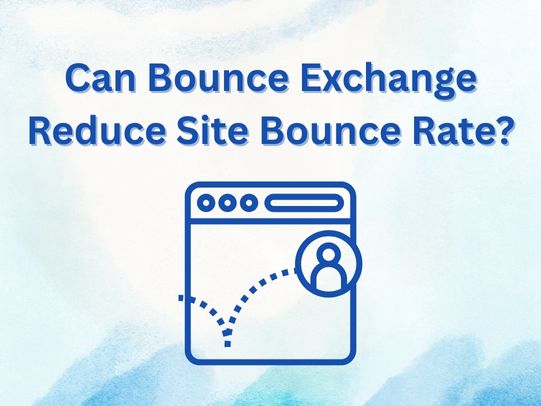A high bounce rate is often a red flag for digital marketers, e-commerce store owners, and business websites. It usually signals that visitors are leaving your site after viewing just one page-without clicking through, engaging, or converting. One advanced tool that promises to tackle this issue is Bounce Exchange (now known as Wunderkind). But how effective is it? Can it really reduce your bounce rate and improve engagement?
This comprehensive guide breaks down what Bounce Exchange is, how it works, real-world use cases, and actionable ways it can improve your site’s performance.
What Is Bounce Exchange (Wunderkind)?
Bounce Exchange is a behavioral automation and exit-intent marketing platform. It helps brands reduce bounce rate by identifying when a visitor is about to leave the site and then triggering personalized messages or calls-to-action (CTAs) that encourage interaction-like signing up for an email list, taking advantage of a discount, or reading more content.
Example:
A user visits your cleaning service website, scrolls briefly, and starts moving their cursor to close the tab. Suddenly, a pop-up appears:
“Wait! Get 15% off your first deep-cleaning service if you book today!”
This incentive may stop the visitor from bouncing and convert them instead.
How Does Bounce Exchange Work?
Bounce Exchange’s technology is based on a combination of behavioral analytics, machine learning, and real-time user tracking.
1. Exit-Intent Detection
The platform detects user actions that indicate intent to leave-like moving the mouse toward the browser’s toolbar or hitting the back button. It reacts immediately with a dynamic message or CTA.
2. Behavioral Segmentation
Bounce Exchange doesn’t treat all users the same. It segments users based on behavior:
- First-time visitors vs. returning users
- Cart abandoners
- Blog readers vs. product viewers
- Device type (mobile/desktop)
3. Dynamic Overlays & Personalization
It triggers customized overlays based on the visitor’s behavior. These can include:
- Email opt-in forms
- Discount offers
- Product suggestions
- Countdown timers for urgency
4. A/B Testing & Analytics
Marketers can test different messages and designs to find out what works best. Built-in analytics help optimize campaigns for conversions, not just clicks.
Can Bounce Exchange Really Reduce Bounce Rate?
Yes-when implemented strategically, Bounce Exchange has a proven track record of reducing bounce rates. Let’s look at why:
✅ It Catches Users Before They Leave
By targeting exit behavior, it captures attention at the most critical moment.
Example:
A digital marketing agency blog might offer a free On page SEO checklist PDF as an overlay just before the user exits. This gives value and encourages interaction.
✅ It Increases Time on Site
Once engaged, users often click through to other pages. The more they explore, the more likely they are to convert.
✅ It Captures Leads
Even if the user doesn’t convert immediately, you can capture their contact info-opening the door to retargeting or email campaigns.
Also check Top Bounce Rate Mistakes That Kill Your SEO Efforts
Key Features That Help Reduce Bounce Rate
- Exit Intent Popups: Timely messages triggered by abandonment signals.
- Behavior-Based Targeting: Personalize based on scroll depth, time on site, pages visited, etc.
- A/B Testing Tools: Optimize message content, design, and triggers.
- Responsive Design: Works seamlessly on mobile and desktop.
- Cart Abandonment Recovery: Reminds users of what they left behind.
- Analytics Dashboard: Provides insights on conversion funnels, bounce behavior, and user segments.
Best Practices for Using Bounce Exchange Effectively
1. Keep Messages Relevant
Don’t show the same pop-up to everyone. Personalization is key.
Example:
Visitors from a “How to Disinfect Your Home During Cold and Flu Season” blog may respond better to an offer like,
“Get your home disinfected-20% off flu-season cleaning today!”
2. Test Often
Use A/B tests to compare:
- Messaging tone (urgent vs. friendly)
- Visuals and colors
- Offers (discount vs. free trial)
3. Don’t Overdo It
Overusing overlays or popups can frustrate users. Trigger them based on actual behavior, not a timer.
4. Map to User Intent
Align your messaging with what the user is looking for. Bounce Exchange works best when it solves a problem the user cares about.
Use Case Examples
Cleaning Service Website
- Bounce Issue: High traffic from blog posts but no service bookings.
- Solution: Offer 10% off first booking via exit popup with booking form.
- Result: 22% decrease in bounce rate and 30% increase in lead capture.
Digital Marketing Agency
- Bounce Issue: Users exit service pages without contacting.
- Solution: Free marketing audit triggered at exit.
- Result: Doubled contact form submissions.
Health and Wellness Site
- Bounce Issue: Users read content but don’t subscribe.
- Solution: Show a personalized exit popup offering a “15 Day Diet Plan for Weight Loss”
- Result: Email list grew by 18% in one month.
FAQs
Q1: Will Bounce Exchange annoy my visitors?
A: Not if used correctly. Avoid aggressive tactics or intrusive popups. Customize content based on user behavior and intent.
Q2: Is it effective for mobile users?
A: Yes. Bounce Exchange offers responsive overlays optimized for mobile devices.
Q3: Does it only help with lead capture?
A: No. It also increases session duration, improves conversions, and recovers abandoned carts.
Q4: Can I integrate it with email platforms like Mailchimp or HubSpot?
A: Yes. Bounce Exchange supports integrations with major CRM and email platforms.
Q5: Is it better than standard popup tools?
A: Yes. Bounce Exchange offers behavior-driven automation and machine learning, not just time-based popups.
Conclusion
Bounce Exchange (Wunderkind) is a powerful and data-driven tool for reducing your site’s bounce rate and increasing user engagement. With its exit-intent tech, behavioral segmentation, and personalized overlays, it offers a smart way to connect with users before they leave your site. When aligned with user intent and backed by continuous testing, it can significantly improve retention, leads, and revenue.


